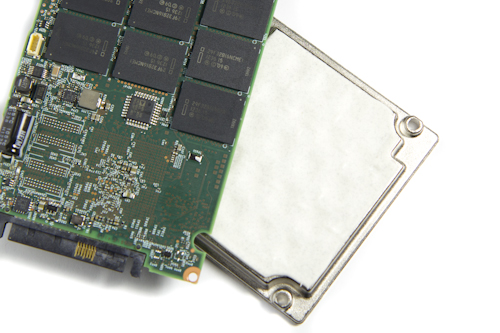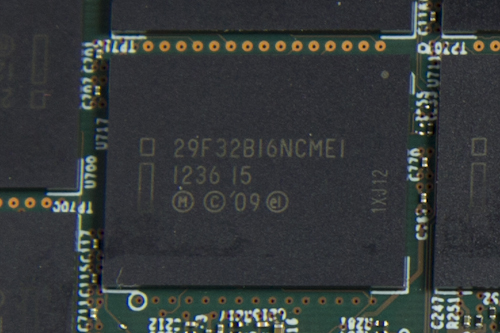LSI SAS 9300-8e & HGST Ultrastar SSD800MM: 12 Gb/s SAS, Tested
With the announcement of LSI's SAS 9300-8e and HGST's Ultrastar SSD800MM earlier this year, the world was officially introduced to 12 Gb/s SAS. Today we get our first look at how two times the interface bandwidth translates to real-world performance.
Inside HGST's Ultrastar SSD800MM
As mentioned, the first think you notice about this drive is its physical size, though most enterprise customers are used to 15 mm drives already. Picking the thing up, you also notice that the SSD800MM weighs a good deal, too. And because this is a prototype, it lacks official labeling.
There's a joke that goes, if you ask Intel why it doesn't offer SAS-based storage products, it'll respond that it does. They just have HGST labels on them. Alright, calling that a joke is a stretch. But prying open the SSD800MM certainly gives it some credence. Everything from the NAND to the PCB's silkscreen is labeled Intel. This partnership goes back to the Intel SSD 910, which used controllers co-developed by the two companies.
This SSD is built like no other I've seen. Once the first four screws and top plate are removed, you see the PCB attached to the bottom plate by four more screws.
On the back of the top plate, there's a large block of aluminum with a thermal gap pad that touches the NAND on the back of the PCB.
Removing the PCB exposes thermal pads for the controller, DRAM, and NAND. Normally, we'd consider this level of thermal management overkill. But remember that this SSD needs to passively dissipate up to 11 W. Even during our testing we had to make sure there was air flowing across the drive.
We don't have a lot of information about the controller, but we of course know it was co-developed by Intel and HGST. Most of the processors we've dealt with up until now were eight- or 10-channel designs; this one employs 12, which makes sense given the high-end specs. Additionally, our 400 GB sample includes two Micron DDR3-1600 memory packages that add up to 1 GB of data cache.
Finally, there are 18 NAND packages (nine on each side). Each one contains 32 GB of 25 nm enterprise-class MLC flash. All told, the SSD800MM hosts 576 GB, which comes out to 44% over-provisioning. That's a ton, even for an enterprise-oriented SSD.
Get Tom's Hardware's best news and in-depth reviews, straight to your inbox.
Current page: Inside HGST's Ultrastar SSD800MM
Prev Page HGST Ultrastar SSD800MM Specifications Next Page Test Setup, Benchmarks, And Methodology-
major-error The performance and relative maturity of this prototype drive certainly is impressive, but this is what the enterprise space demands.Reply
At the consumer level though, the article takes on a completely different tone--I would be very surprised if we don't start seeing mention of PCIe4 at/before the top of the next CPU cycle (so, in 24-36 months at most.) -
raidtarded Actually, Adaptec already saturated PCIe 3.0 with 6GB/s. The chart is incorrect, it doesn't take 12Gb/s to saturate the PCIe bus. Well, not for Adaptec.Reply -
falcompsx Remember when mechanical hard drives struggled to saturate their interfaces? Times sure have changed with SSD tech.Reply -
CaedenV Reply11006286 said:The performance and relative maturity of this prototype drive certainly is impressive, but this is what the enterprise space demands.
At the consumer level though, the article takes on a completely different tone--I would be very surprised if we don't start seeing mention of PCIe4 at/before the top of the next CPU cycle (so, in 24-36 months at most.)
Ya, my bet is that we will not start to see SATA4 or PCIe4 until Skymont at the earliest. Considering it is looking like Broadwell may be pushed back due to 14nm die shrink issues I would bet that Skymont will have similar issues when moving to 10nm. But at least for home users you can cram 2 SSDs in RAID0 with a proper RAID card and get a little performance boost until then. I guess the only problem is that most people are going to use the onboard Intel RAID for RAID0, which will get you a killer synthetic benchmark, but in practical reality it is really just expanding your volume with very little speed benefit. -
bit_user * wipes drool off floor *Reply
That's a quality review of some quality products. I like the insights shared, throughout. I especially appreciated the link to the SATA-Express paper. Thanks!
MORE REVIEWS LIKE THIS!!
:) -
bit_user Reply
How many ports and how many lanes, though? If it's just a 8-port card, the math doesn't support that, as 6x8 = 48 Gbps, which is less than the 8 x 8 = 64 Gbps that a x8 PCIe 3.0 slot should carry.11006482 said:Actually, Adaptec already saturated PCIe 3.0 with 6GB/s. The chart is incorrect, it doesn't take 12Gb/s to saturate the PCIe bus. Well, not for Adaptec.
-
raidtarded It is the equivalent of a nuke bomb compared to the LSI products. It has 24 Native ports.Reply11011736 said:
How many ports and how many lanes, though? If it's just a 8-port card, the math doesn't support that, as 6x8 = 48 Gbps, which is less than the 8 x 8 = 64 Gbps that a x8 PCIe 3.0 slot should carry.11006482 said:Actually, Adaptec already saturated PCIe 3.0 with 6GB/s. The chart is incorrect, it doesn't take 12Gb/s to saturate the PCIe bus. Well, not for Adaptec.





